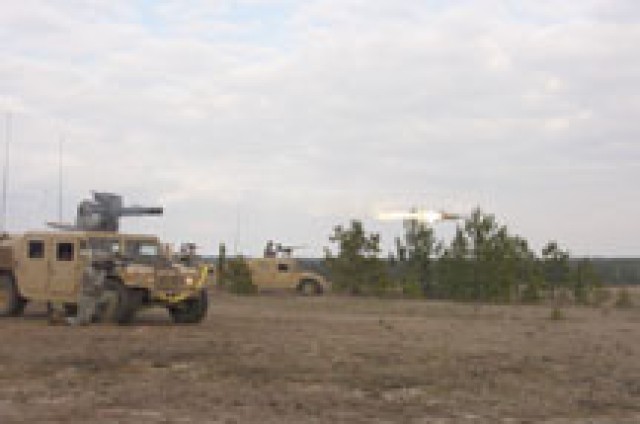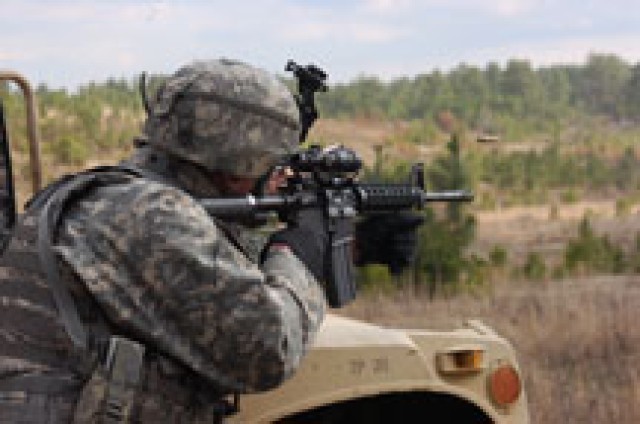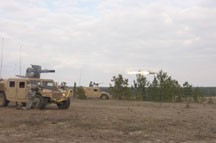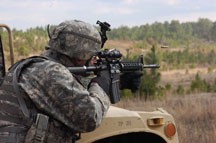FORT POLK, La. - While training at Peason Ridge March 1, 3rd Squadron, 89th Cavalry Regiment, 4th Brigade Combat Team, 10th Mountain Division Soldiers fired tube-launched-optically tracked-wire-guided (TOW) missiles using live rounds for the first time in the squadron's history.
The milestone event occurred as 3-89 Cav Reg conducted a platoon situation training exercise. There is a significant difference between firing a TOW using live rounds as compared to concrete rounds, said Staff Sgt. Daniel Dobbs, 3-89 Cav Reg's squadron targeting non-commissioned officer.
"It gives the guys the ability to see what a live TOW can do without watching it on a TV," said Dobbs. "They can see what a detonation of a live TOW can do to one of the targets ... out in the training area."
Dobbs explained that the TOW missile launcher is traditionally an anti-armor weapon, but Soldiers can use them against hard structures and soft-skinned vehicles. He described a situation in which a TOW, which has a maximum range of more than 3,000 meters, might be used in Afghanistan.
"You could have a TOW missile set up in a dismounted configuration at a combat outpost and you're taking contact from a mountainside or vehicle with a weapon mounted on it," said Dobbs.
"If they are shooting at you, then you can engage those personnel ... with a TOW missile. You can use it as a defensive weapon ... or you can use it on trucks as an offensive weapon."
During the lanes, Soldiers did not just drive to a location, set up their TOWs and fire at a target. The squadron set up a simulated patrol lane that platoons had to negotiate as they encountered enemy fire.
The scenario was a platoon route-reconnaissance patrolling to a village, reacting to contact and executing mounted and dismounted battle drills. The lane is "similar to what they would have to do in Afghanistan," said Lt. Col. Phillip Chambers, 3-89 Cav Reg squadron commander.
Along the route, platoons faced enemy fire from different directions while searching for improvised explosive devices and calling for fire support. At one point, platoons had to fight off enemy small arms fire, call for mortar support and employ their TOWs against a specified target simultaneously.
Chambers said many of the squadron's platoon leaders are about to transition to higher positions, and 3-89 Cav Reg will conduct platoon live fire exercises again with new platoon leaders during upcoming off-post training at Camp Guernsey, Wyo. However, it is good for them to receive this training before moving on.
"I felt it was important that I kept them in the platoons because this is a critical building block in their leader development -- to be able to execute a platoon live fire," said Chambers. "If they are going to be a troop commander one day, they need to have this kind of activity under their belts and (ensure) they are ready to understand and run platoon training as a troop commander."
Sgt. Maj. Michael Stunkard, squadron operations command sergeant major, said the platoon live fire exercise, which incorporated indirect fires, mounted and dismounted elements and the TOW missile shoot, was a good training opportunity for TOW truck crews. However, Soldiers in the tactical operations center gained valuable experience in the clearance of fires.
Coordinating indirect fires played a large part during the squadron exercise. Dobbs said when platoons want to use indirect fire support they usually call for mortars because they are the most responsive indirect fire asset. He explained that forward observers will call and request clearance of fires for a certain grid. Then, tactical operations center personnel coordinate to ensure there are no "friendlies" in that battle space and that the grid is clear and safe to fire rounds at the target.
"That is valuable, because in Afghanistan, the indirect fire part of it, mortars and artillery and things of that nature come into play a lot more," said Dobbs.
Stunkard said 3-89 Cav Reg platoons are gaining confidence in their use of indirect fire.
"They are getting better every day putting steel on target -- first round (and) working on their adjustments," said Stunkard. "That is what we are doing, trying to replicate conditions in Afghanistan and incorporate as much combined arms as we can."




Social Sharing